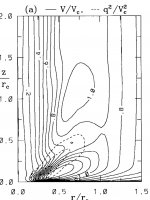Caleb Routt
EF1
First off I highly recomend this paper here: http://journals.ametsoc.org/doi/pdf/10.1175/1520-0469(2000)057<0527:TIOALS>2.0.CO;2
Not sure if there is a whole thread on this however this stuff is really interesting.
The Corner Flow structure really determines what kind of flow a tornado has. Basically the corner flow occurs because tornadoes have very low pressure inside them. This draws air in radially to try to fill the pressure minimum inside the core. But because tornadoes spin centripital force centrafuges the air away. Tornadoes also have an updraft that is caused by pressure gradient forces above the boundary layer. When the air gets close to the perimeter of the vortex air then gets centrafuged away and carried upward by updraft. The transition from horizontal radial inflow to ubrupt vertical flow is known as the corner flow region. The structure inside the tornado is determined by a measurement called "Swirl Ratio" Swirl Ratio is the tangental velocities to updraft. Swirl Ratio can also be thought of as how well the vortex is in a state of Cyclostrophic Balance. In the cases of a "Very low swirl tornado" the flow is mainly inward moving air and then upward moving air to the parent thunderstorm. In a "medium" swirl fluid the flow is mainly laminer at the boundary layer and then flows around the downdraft caused by the tornado being in Cyclostrophic Balance a little above the surface. Tornadoes with "High Swrl Fluid" consist of a downdraft that touches the ground surrounded by updraft. The image below gives a great visualation of a high swirl tornado. The isobars are very compact near the corner flow region which indicates the tornado is pulling in a vast amount of inflow and is turning ubruptly upward. This region is also angled outward because of strong centripital force and the flow must go around the downdraft caused by Cyclostrophic Balance.
Not sure if there is a whole thread on this however this stuff is really interesting.
The Corner Flow structure really determines what kind of flow a tornado has. Basically the corner flow occurs because tornadoes have very low pressure inside them. This draws air in radially to try to fill the pressure minimum inside the core. But because tornadoes spin centripital force centrafuges the air away. Tornadoes also have an updraft that is caused by pressure gradient forces above the boundary layer. When the air gets close to the perimeter of the vortex air then gets centrafuged away and carried upward by updraft. The transition from horizontal radial inflow to ubrupt vertical flow is known as the corner flow region. The structure inside the tornado is determined by a measurement called "Swirl Ratio" Swirl Ratio is the tangental velocities to updraft. Swirl Ratio can also be thought of as how well the vortex is in a state of Cyclostrophic Balance. In the cases of a "Very low swirl tornado" the flow is mainly inward moving air and then upward moving air to the parent thunderstorm. In a "medium" swirl fluid the flow is mainly laminer at the boundary layer and then flows around the downdraft caused by the tornado being in Cyclostrophic Balance a little above the surface. Tornadoes with "High Swrl Fluid" consist of a downdraft that touches the ground surrounded by updraft. The image below gives a great visualation of a high swirl tornado. The isobars are very compact near the corner flow region which indicates the tornado is pulling in a vast amount of inflow and is turning ubruptly upward. This region is also angled outward because of strong centripital force and the flow must go around the downdraft caused by Cyclostrophic Balance.


